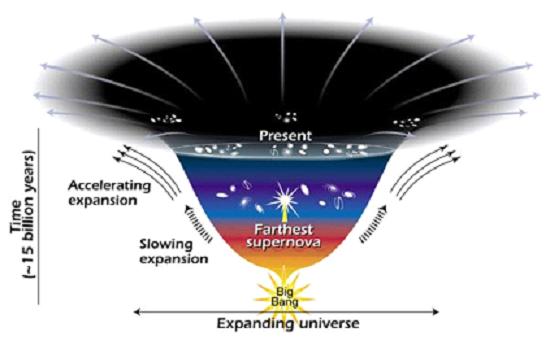Is the Universe Recession Proof?
Dec
10, 2009
Cosmologists are no closer to
solving the dark energy problem.In 1998, two astronomical
research teams independently discovered what is now called "dark
energy." Saul Perlmutter of the Lawrence Berkeley National
Laboratory and Brian Schmidt from the Australian National
University projects each led the two teams who discovered that
the Hubble Constant, a uniform expansion rate imparted to the
universe from the Big Bang explosion, was accelerating.
Certain concepts, like redshift and gravity, are fundamental to
the Big Bang hypothesis. According to theory, light shifts
toward the red end of the spectrum because an object is moving
away. Because objects interpreted to be at great distances move
away faster than objects nearer to Earth, the universe is
expanding. The usual understanding is that galaxies are all
moving away from each other because the universe is growing
larger.
Another important principle is that the universe is
gravity-driven. If gravity is the only controlling force, then
the expansion set in motion by the Big Bang must be slowing
down—an inescapable conclusion based on gravitational
attraction.
However, Perlmutter and Schmidt realized from the study of Type
1a supernovae that the expansion of the universe was not slowing
down, instead it was accelerating. When the astronomers plotted
redshifted "velocities of recession," the figures suggested that
the expansion rate of the universe is greater today than in its
early days.
In order to analyze the influx of computer data from telescopes
around the world and out in space, the GRavitational lEnsing
Accuracy Testing 2008 (GREAT08) PASCAL Challenge, a group of 38
scientists from 19 international institutions, hopes to solve
the riddle of dark acceleration in the Hubble Constant by 30
April 2009. Because the data is primarily images of supernovae
and their spectrographs, the computational requirements could be
distributed across a wide assortment of disciplines—some not
necessarily in the astronomical realm. By making use of
distributed processing, astronomers can unburden their own
computer resources and use any number of voluntary subscribers
for assistance. Who knows, in the near future your computer may
be helping to remove image artifacts from Hubble Space Telescope
data.
But is all this
effort necessary? Even some NASA scientists are questioning the
existence of dark energy. What is the more likely explanation
for the supernovae anomalies that led to the dark energy theory?
Cosmologists made their first mistake when they ignored
electricity as a significant force in the cosmos. For example,
Supernova 1987a, the closest supernova to Earth ever
studied, exhibits unmistakable signs of electrical discharge.
Size,
color, and luminosity reveal nothing
about a star's age. A red giant star
is big because there is low
electrical stress in the star's
connected circuit. A blue-white
star, on the other hand, is under
extreme electrical stress—so much so
that it could explode due to a
breakdown in its double-layer
envelope or due to electrical
fissioning. No assumption about a
star's age can help when trying to
determine if it will explode.
The
Supernova Legacy Survey discovered that the "brighter"
supernovae were more common in the past and that they were about
12% brighter 8 billion years ago than they are now. No one knows
why the early universe had more of the Type 1a supernovae. One
observation does show a clue: the brighter starbursts
are found more often where there is a high rate of star
formation.
As the Electric Universe
postulates, more stars are born where there are greater flows of
electric current. That current flow could also initiate a
greater number of stellar explosions.
Because the observed correlation of luminosity with redshift is
due to the electrical stress rather than to the distance of the
object, highly charged, nearby
objects look like remote,
high redshift supernovae that are too bright for their distance.
One can imagine the theoretical problems that would result from
that misinterpretation.
By Stephen Smith







